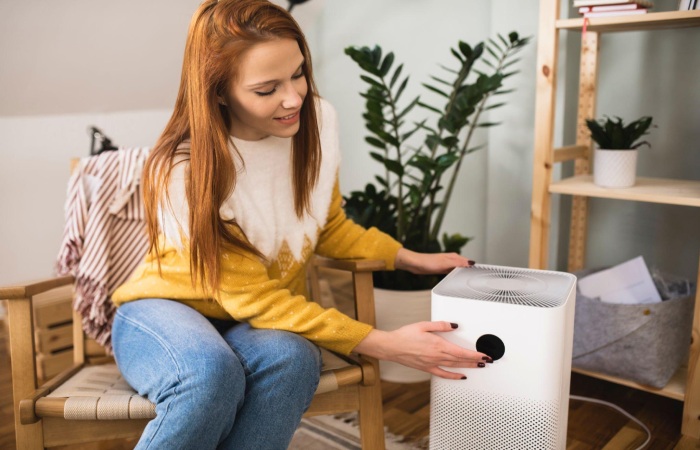Air Purifier Write For Us

Air Purifier Write For Us: A purifier, often called an air purifier or an air cleaner, is a device designed to improve air excellence in indoor spaces by removing pollutants, allergens, and contaminants from the air. These devices are commonly used in homes, offices, and other indoor environments where air pollution or respiratory issues may be a concern.
So, Once your article meets our guidelines, you can send it to contact@thewikiguide.com.
Here are the Key Aspects of Air Purifiers
Air Filtration
The prime function of an air purifier is to filter the air and remove particles and pollutants. Most air purifiers use filters, such as High-Efficiency Particulate Air (HEPA) filters, to capture and trap particles like dust, pollen, pet dander, mold spores, and other airborne pollutants. HEPA filters effectively remove particles as small as 0.3 microns, providing clean air.
Noise Level
Consider the noise level produced by the air purifier, especially if you plan to use it in areas like bedrooms or offices where quiet operation is desired. Some models have built-in noise reduction technology or offer different fan speed settings to adjust the noise level.
Additional Features
Air purifiers may include additional features such as air quality sensors that detect pollutants and adjust the purification settings accordingly, programmable timers, air quality indicators, remote controls, and Wi-Fi connectivity for remote monitoring and control via smartphone apps.
Maintenance and Filter Replacement
Regular maintenance and filter replacement is essential for the optimal performance of an air purifier. Check the manufacturer’s recommendations for filter replacement frequency and availability to ensure convenience and cost-effectiveness.
Activated Carbon Filters
Some air purifiers include activated carbon filters alongside HEPA filters. Activated carbon is highly effective in adsorbing and neutralizing odors, smoke, chemicals, and volatile organic compounds (VOCs) from the air, refining indoor air quality.
Pre-Filters
Many air purifiers feature pre-filters that help capture larger particles like dust and hair, prolonging the primary filter’s life and improving the purification process’s overall efficiency.
Air Exchange Rate and Coverage Area
Air purifiers are designed to clean an exact air volume per unit of time referred to as the air exchange rate. The higher the air exchange rate, the faster and more frequently the air in a room will purify. The coverage area specifies the maximum room size that the air purifier can effectively clean. Choosing an air purifier with an adequate air exchange rate and coverage area for your specific needs is essential.
Energy Efficiency
Look for air purifiers that are energy efficient, as indicated by the ENERGY STAR label or other energy efficiency certifications. Energy-efficient models can help reduce electricity consumption and lower operating costs.
When selecting an air purifier, consider the room size, the specific pollutants you want to target, and any specific needs or sensitivities you may have. Reviewing and comparing dissimilar models can also help you make an informed decision.
While air purifiers can improve indoor air excellence, they are not a substitute for good ventilation, proper cleaning practices, and addressing the underlying causes of indoor air pollution.
How do I Submit a Guest Post?
So, Once your article meets our guidelines, you can send it to contact@thewikiguide.com. We are happy to hear from them.
Then After submission, our group will review it, check if the content is unique, and approve it.
Why Write For The Wiki Guide – Air Purifiers Write for Us

- To Share Information: Websites often provide a platform for people to share their ideas, opinions, or knowledge on a particular topic. Writing to a website like Glamour Genix could be an opportunity to share valuable information with others interested.
- To Ask for Advice or Assistance: Some websites offer advice or assistance on specific topics, such as health, finance, or education. Writing to a website like Glamour Genix could be a way to ask for help or guidance on a particular issue.
- To Provide Feedback: Websites often welcome feedback from their users, whether it’s about the content, design, or functionality of the site. Writing to a website like Glamour Genix could be a way to provide feedback on your experience with the site.
- To Request Information: Websites often provide information on a particular topic, such as news, events, or products. Writing to a website like Glamour Genix could be a way to request more information on a topic of interest.
- Social Networks: We are also present on social networks and will share your article on our social networks.
- Write For Us: If you write for us, your brand and content will be recognized worldwide.
- Build Relationships: This will help build relationships with your target audience.
Ultimately, the reason for writing to a website will depend on the individual’s needs and interests, as well as the purpose and focus of the website itself.
Search Terms Related to Air Purifier Write for Us
- Air purifier
- Honeywell air purifier
- HEPA air purifier
- Dyson air purifier
- Germ guardian air purifier
- HEPA filter air purifier
- Winix air purifier
- car air purifier
- Honeywell air purifier filter
- Holmes air purifier
- Holmes air purifier filter
- Nature fresh air purifier bags
- Molekule air purifier
- Germ guardian air purifier filter
- Levoit air purifier replacement filter
- Levoit air purifier
- Ozone air purifier
- Ionizer air purifier
- Rabbit air purifier
- Air purifier filter
- Ozone generator air purifier
Search Terms for Air Purifier Write for Us
air purifier written for us
Air purification blog
indoor air quality submit
allergies write for us
asthma writes for us
pollen writes for us
dust mites
pet dander
smoke
mold
bacteria
viruses
HEPA filter
activated carbon filter
CADR
AHAM Verified
Energy Star
best air purifiers
air purifier reviews
air purifier buying guide
allergies
Asthma
air purifier for smoke
air purifier for mold
large rooms air purifier
Small rooms
air purifier for bedrooms
air purifier for living rooms
Guidelines of the Article – Air Purifier Write for Us
Before you write or submit a story to Result First, we want you to know our policies. We ask that you carefully recite and follow these guidelines:
- The guest post must cover at least 800 more words.
- An article should be valuable and obliging to the user deprived of time-limited language.
- The article must be 100% sole and free from copyright breach and must not contain syntactic errors.
- The article or blog admission must, in any case, cover two important copyrighted images.
- The point must remain recognized within the domain: automobiles, auto parts, cars, bikes, etc.
- Our quality checks will check the nature of the substance, the specialized SEO, and the rank of the connection. In case all are rendering to our rules, at that time, the live joining of the item will continue to be sent within 2 hours.
- You can send us the ideas, and you can submit the article to contact@thewikiguide.com
Related Pages
Best body lotion Write For Us
Technology Write For Us
Health Insurance Write For Us
Beauty Write For Us
Cosmetic Write For Us

